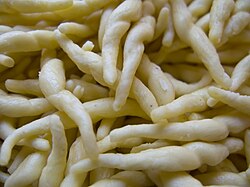Trofie
Type of pasta from the Liguria region of Italy From Wikipedia, the free encyclopedia
Trofie (Italian: [ˈtrɔːfje]), less frequently troffie, strofie or stroffie, is a short, thin, twisted pasta from the Liguria region of Italy.
Etymology

The origin of this pasta name is not certain. It is believed to come from the Ligurian verb strufuggiâ, meaning 'to rub', as a reference to its method of preparation, which consists in "rubbing" or rolling a small piece of dough on the pastry board.[1] Similarly, the root of Ligurian strofia might be Ancient Greek στρωφάω, 'to twist, to spin', or στρέφω, 'to cause to rotate, to twist, plait',[a] referring to the same motion required to produce trofie.
Description
Trofie are shaped by rolling a small piece of dough on a flat surface to form a short, round length of pasta with tapered ends, then twisting it to form the final shape. It is around 2–3 cm (3⁄4–1+1⁄4 in) long with a diameter of roughly 4 mm (3⁄16 in).
In Ligurian cuisine, it is most typically served with a pesto sauce.
History
Modern trofie seems to originate from Golfo Paradiso, a strip of land in the Riviera di Levante including maritime towns like Recco, Sori, Camogli and other comuni (municipalities) in the area.[2] This pasta shape was not so common in Genoa until the mid-20th century, though the term trofie was already in use there and referred to gnocchi as a whole.[2] Genovese trofie was traditionally made with either wheat or chestnut flour and, from the beginning of the 19th century, with the addition of potatoes also.[2]
Today, trofie is a staple of modern Ligurian cuisine. It is also made in a small version called trofiette in Italy.
See also
![]() Media related to Trofie at Wikimedia Commons
Media related to Trofie at Wikimedia Commons
Notes
- These verbs have been rather prolific in Italian language, as they have produced a number of nouns such as strofa (stanza), strofio (i.e. a classical woman's bustband or also a man's headband), apostrofo (lit. 'apostrophe'), catastrofe (lit. 'catastrophe'), etc.
References
Wikiwand - on
Seamless Wikipedia browsing. On steroids.

